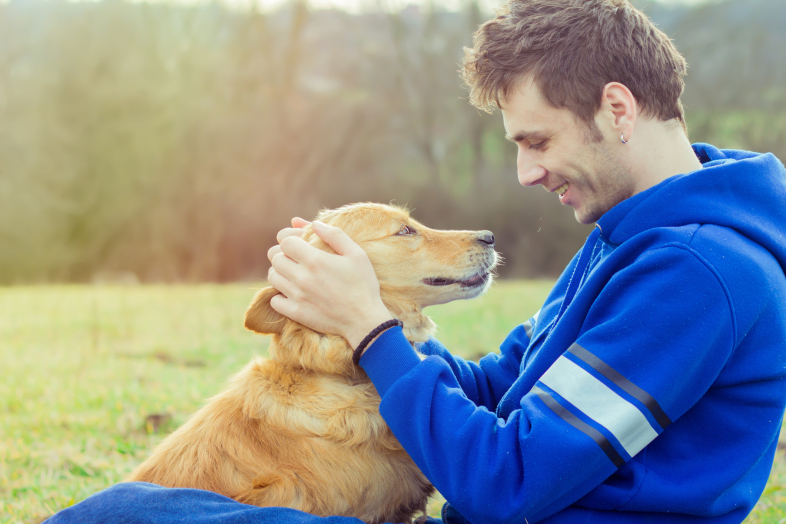Benefits of Relationship Based Dog Training


Relationship-Based Dog Training: Benefits
By Best Friends’ behavior consultants
The behavior consultants at Best Friends have found that animal training built on a trusting relationship is the most kind — and also the most effective — method of training. When you have a trusting, cooperative relationship with an animal (whether it’s a dog, cat, parrot, horse or other animal), you have his respect, and he’ll want to spend time with you and work with you. Best Friends does not stand behind training methods that use excessive force, threats, fear, intimidation, pain or dominance. Training based on such aversive methods damages any sort of trusting relationship you might develop with the animal.
Relationship-based training is effective for either teaching new behaviors or changing current behavior for any physically and mentally healthy animal. By reinforcing behaviors you like and want to continue seeing, you set the animal up for success. Regardless of an animal’s age and past experiences, such ethical training methods give the animal the best chance for living happily and comfortably in our hectic human world.
It is also important to understand that every interaction is a learning experience, so every time you interact with your pets you are training them, whether or not you intend to. Relationship-based training is a lifestyle — a constant dialog with your pets, rather than a one-way issuing of commands that only occurs in structured training sessions. So instead of waiting for the occasional chance to work on modifying the animal’s behavior, it’s better to be aware of every opportunity to arrange your pet’s environment to reinforce the behaviors you want.
Dog training tips
What exactly do we mean when we say “relationship-based training”? It is a method of training that uses the cooperative relationship between the trainer and the animal to achieve mutually beneficial results, while at the same time enhancing and strengthening their relationship. Here are some of the basic principles:
- Put the animal’s immediate needs first. Is your pet injured, ill, fearful, frustrated, hungry, thirsty, needing to eliminate? Put off training until the animal’s immediate needs have been met and he or she can concentrate on the training exercise.
- Learn to accurately interpret animals’ body language. There are a lot of common misconceptions about animal body language, especially for dogs, due to the prevailing myth of dominance-based social structures. These misconceptions frequently lead to human misinterpretation of the animal’s emotional state and intentions. For this reason, it is important to get sound, science-based information about the body language of the species you are working with. All species exhibit telltale signs that let you know how the animal is feeling, whether it’s joy, anger, fear, frustration or some other emotion. Understanding body language improves communication between people and animals, and helps keep all involved safe.
- Find out what motivates the animal (e.g., treats, affection, verbal praise, toys) and use it to your advantage. It’s also important to first make sure the animal is motivated to work with you. We tend to assume that pets should automatically adore us, but that isn’t always the case. So the first step is to build a relationship with the animal by spending time with him and creating an association between your presence and things he really likes.
- Use positive reinforcement to encourage behavior you want. You can elicit and reinforce desired behavior through the techniques of capturing, luring, shaping or cueing.
- Avoid aversive methods. Aversive methods such as force, threats, fear, pain, intimidation and dominance are not necessary for eliminating undesirable behaviors. In fact, aversive methods often have many damaging side effects. Instead, ignore the unwanted behavior and/or teach incompatible behaviors. For example, you can teach a dog to sit and stay for a greeting rather than jumping up; it’s impossible for him to do both simultaneously. To reinforce the desired behavior, reward the dog with whatever motivates him, whether it’s treats, affection, verbal praise, toys or something else. In contrast to aversive-based training, this approach supports the trusting and cooperative relationship between you and the animal.
- Prevent the animal’s ability to continue practicing unwanted behaviors by controlling the environment and controlling the animal’s exposure. For example, distract a reactive dog or limit access to a window, door or fence line if the inappropriate behaviors are happening there.
- Supervise the animal carefully to set him or her up for success. You can avoid or prevent unwanted behaviors by simply being aware of what your pet is doing. For example, if a new dog or puppy is not house-trained, don’t allow her the full run of the house until she has been house-trained. Giving an animal too much freedom before she has the necessary life skills to navigate that much space can set her up for failure.
- When an animal’s behavior is rooted in a strong emotional state (fear, anger, frustration or even excitement), change the behavior by changing the underlying emotional state. You can do that by pairing the stressful situation with something the animal really loves until she feels calm and happy around whatever previously upset her. For example, if a dog gets upset when strangers walk by her gate, we can change the way she feels about strangers by having them toss treats over her gate every time they pass by.
Relationship-based dog trainers
Relationship-based trainers also have realistic expectations. When training animals, we use lots of patience. We understand that animals are not born knowing how to fit into our human lives. Most adult animals we meet have not been properly taught how to be part of a loving human family. Even if they have been in a loving home, they may still lack the social skills to be comfortable around strangers and in new situations. Expecting an animal to know everything is unrealistic and punishing an animal for not knowing something is unfair. In relationship-based training, every animal is seen as an individual and the trainer works with the animal on that basis.
Over the years, as we’ve worked in this field, we’ve become familiar with many other training techniques through working with other trainers and veterinarians, attending conferences, reading books and watching training videos. Our exposure to other training methods only confirms our belief that relationship-based training is more efficient, more effective and safer. It creates less collateral damage in the learner, and is more mutually beneficial to both the animal and the trainer. But it isn’t just our personal experiences and beliefs that drive us to endorse relationship-based training. Many, many studies (dating back to Pavlov’s famous experiments with dogs) have confirmed that such kind and ethical training techniques deliver the most effective and reliable training results.
For these reasons, Best Friends’ behavior consultants have chosen not to use aversive training methods, especially after seeing their detrimental effects on animals. These methods can cause confusion in the animal, lack of trust, breakdown of the relationship, physical injury, fear and so-called “unpredictable” behavior. Examples of aversive training methods include:
- Dominance and physical force: pushing a dog into a sit or down position, alpha rolls, physical punishment (hitting, kicking, slapping, hanging, finger jabs)
- Leash corrections
- Harsh tones, verbal reprimands, the “alpha” voice
- Methods that rely on inflicting pain, such as pinch or prong collars, choke chains and shock collars
- Interrupters such as shaking a can, throwing objects at animals, or otherwise using sudden and/or loud stimuli to scare them
Besides the potentially damaging effect on the animals, and the fact that these techniques don’t work over the long term, aversive methods can result in injury to people and death to animals. How? People who use these techniques can be injured when the animals fight back by biting, kicking, scratching or otherwise inflicting injury. Those animals are then sometimes killed after their people decide they can no longer trust them.
Collectively, we have trained thousands of animals and dozens of species — not just dogs — and relationship-based training has worked for all of them. At the Sanctuary, we receive animals from all over the country, many of whom have been previously trained with aversive methods and who have serious behavior issues, and still relationship-based training has worked for all of them. The success rate for relationship-based training of all species greatly exceeds that of aversive- or dominance-based training.